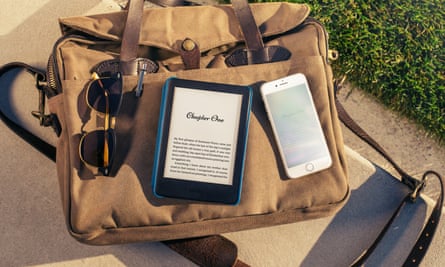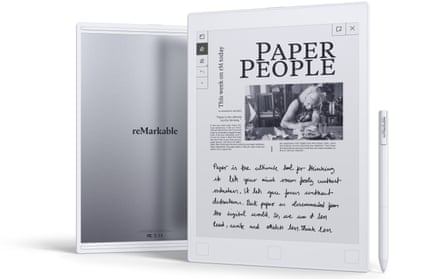I am looking for an e-reader for technical papers. These are usually only available in fixed, non-reflowable, PDF format and sized for printing on A4 paper. They cannot be read on a typical e-reader such as a Kindle because the text is too small. I don’t need the fancy note-taking capabilities of options such as the Remarkable PDF reader. Can you recommend something that doesn’t cost as much as a decent laptop? Thomas
The main attraction of Adobe’s Portable Document Format (PDF) is that people can read the files on almost any kind of device. The corollary is that almost any device will work as a PDF reader, including smartphones, tablets, laptops and desktops running almost any operating system. Indeed, so many people need to read PDF files for business and educational research purposes, there are e-readers designed for the task.
The Guardian’s product and service reviews are independent and are in no way influenced by any advertiser or commercial initiative. We will earn a commission from the retailer if you buy something through an affiliate link. Learn more.
Your challenge is to balance things like text clarity, screen size, portability, battery life, ease of use, versatility and price to arrive at the best choice for your personal needs.
Most of us prefer versatility. A smartphone is not the best camera, notebook, word processor, audio recorder, radio, MP3 player, map reader, pedometer and so on, but it is good enough replace numerous separate devices for most people most of the time. In this case, you seem to want a dedicated device, where the extra features of, say, convertibles running Microsoft Windows 10 are more of a drawback than a benefit.
However, dedicated devices need to outperform general-purpose devices to find a market, and they will still sell in much lower volumes. As a result, they will be relatively expensive.
If you are buying something for business purposes, reconsider your approach to pricing. I calculate the number of hours of use per week, and the number of years of use, to get a cost-per-hour. I compare this against the cost of labour (salary plus overheads), and calculate benefits such as time savings and the ability to work when it would otherwise be impossible.
When people are earning £25,000 to £250,000 a year, it’s generally easy to demonstrate the economic value of expensive devices. Even if you’re a student and not earning anything, you can still value your time.
Screen matters

Mass market e-readers such as Amazon Kindles are designed to replace printed books, so they tend to be around the size of a novel, only thinner. They have E-Ink screens that – unlike laptop screens – are readable outside. They don’t require much battery power, so they can run for many hours between charges. They are exactly what you want, except for their screen sizes.
For your purposes, the best screen size would be 210 x 297mm, which is the same as A4 paper. This has a diagonal of 14.3in, so a 14in screen would be closest to life size. However, a 12.3in to 13.3in screen should be perfectly acceptable.
The other key point is the aspect ratio of 1:1.414. Since you can’t get A4, the best match would be a device with a 3:2 screen, such as a Microsoft Surface Book or a Google Pixelbook. These screens have an aspect ratio of 1:1.5.
The next best would be either 4:3 (1:1.333), which was used by traditional TV sets, or 16:10 (1:1.6), as used by, for example, Apple’s MacBook Pro. The 4:3 format lives on in screen resolutions from 640 x 480 (VGA) to 1440 x 1080 and 1920 x 1440, while 16:10 resolutions include 1440 x 900, 1920 x 1200 and 2560 x 1600.
Unfortunately, the cheapest screens are 16:9 widescreens, which is partly why they are used in cheap laptops. Their 1:1.778 aspect ratio is not a good fit for A4’s 1:1.414. You could try viewing some PDF files on a 1920 x 1080 aka Full HD screen to see if it meets your needs. If it does, cheap convertibles like the Linx 12X64 (£256.98) might be worth considering.
However, E-Ink screens are much easier on the eyes.
Dedicated e-readers

The reMarkable PDF reader is really targeted at the digital writing market, rather than the digital reading market, though most serious e-readers support pens for annotations and signatures. Instead, consider the Onyx Boox range, which includes seven e-readers with larger screens. The top models – the Max 2 ($749) and Max 2 Pro ($849) – would be best for your purposes, because they have 13.3in screens. The 10.3in Note Pro ($599), Gulliver Note ($449) and 9.7in Euclid ($319) are cheaper but smaller options. As you know, reducing the size of PDF images makes them harder to read.
Of course, Sony is the big name in serious e-readers, and it’s Japanese rather than Russian. Alas, Sony’s 12.3in DPT-RP1 would set you back £699, which is about the same as a decent laptop. But according to A L Blair’s most helpful Amazon review, the DPT-RP1 lasts a couple of days per charge, which is more than you’d get from a conventional tablet or laptop.
Boyue’s 10.3in Likebook Mimas is a cheaper but somewhat small option. Its Chinese manufacturer sells it online for €462.91 (£414.26), while Amazon.co.uk is selling it for £415.85. It might sometimes be cheaper on AliExpress. If shopping around, this year’s Mimas has an RK3368 chipset and a Type-C port, while the Likebook Note is an older model.
According to the the-ebook-reader.com website, Boyue is about to launch a Likebook Alita which “looks strikingly similar to the Onyx Boox Note Pro. Their shameless copying of Onyx is starting to get kind of creepy. Half their software features were taken from Onyx’s software and now their hardware is a near replica too.” Judging by comments, Boyue has some software problems, too…
The Onyx Boox and Likebook ranges are based on Android 6.0.1, and therefore might be able to run alternative PDF readers from the Google Play store. Check first if you intend to try this. However, most Android apps are not designed to run on high-resolution e-ink screens.
Alternative devices

As mentioned, you could buy a more versatile device such as an Apple, Android or Windows tablet. These have more features than e-readers, but they don’t havee-ink screens or such good battery life. Worse, if you buy one with decent screen resolution, you may not save any money over an e-reader.
The Apple iPad is a terrific tablet for reading PDF files, but the model with the biggest screen, the 12.9in iPad Pro, starts at a ridiculous £969. The 10.5in iPad Air (from £479) and the 9.7in iPad (from £319) are more reasonably priced, but cost about the same as Onyx Boox e-readers with similar-sized screens.
Android tablets are cheaper, and worse, but you could buy a 10.6in Huawei MediaPad M5 for £299. Its 2560 x 1600-pixel Quad HD screen – which has a 16:10 aspect ratio – might make this the best, cheap PDF reader without an e-ink screen.
Obviously there are much cheaper Android tablets with 10.1in screens, such as the Lenovo Smart Tab P10 (£199) and the Acer Iconia One (£129). However, you pay the price in terms of lower screen resolution. Lenovo’s P10 has a 1920 x 1200 screen, while Acer’s Iconia is down to 1280 x 800 pixels. Both of these are 16:10 ratio screens.
Google’s 12.3in Pixel Slate offers 3000 x 2000 pixels, which is nice, for £749, which is not. No wonder Google is getting out of the tablet business.
Finally, Microsoft’s Surface Pro machines make excellent PDF readers and editors, as well as doing much more besides. You could get the latest Surface Pro 6 with an Intel Core i5 for £774.99 (tablet only); its 2736 x 1824-pixel screen has a 1:1.5 ratio. A refurbished earlier model from the Pro 3 onwards might be an option, but I’d worry about the state of the battery. Otherwise, some regular readers are more familiar with Chuwi-type Chinese versions of the Surface Pro range than I am …
Have you got a question? Email it to Ask.Jack@theguardian.com

Comments (…)
Sign in or create your Guardian account to join the discussion